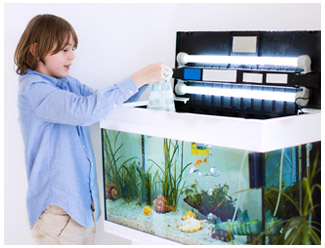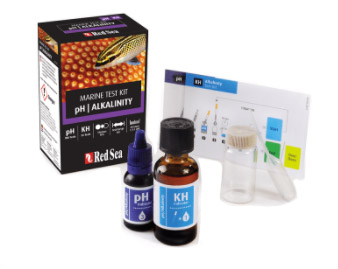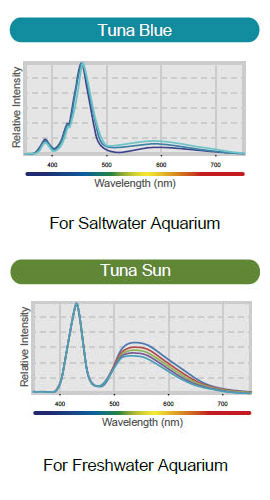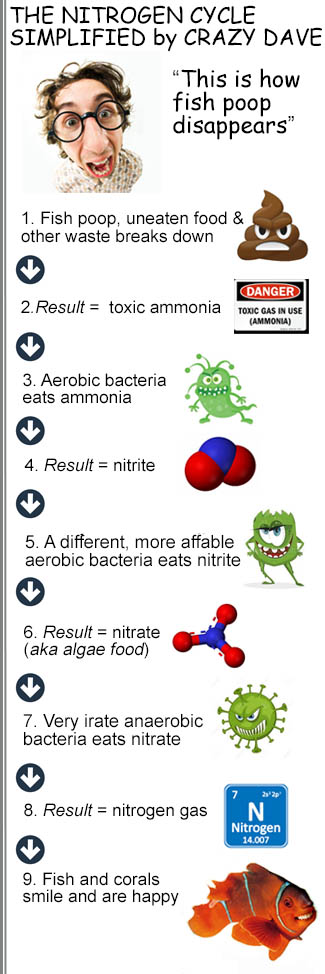What Aquariums Can Teach Kids

Setting up and maintaining an aquarium is a great way to bond with your children. It’s also a great way to teach your children about science. Pretty much everything covered in K-12 science is relevant to the understanding of aquariums. Pretty much everything related to creating and maintaining an aquarium is relevant to K-12 science.
Learning through doing is always superior to theoretical learning. With an aquarium the consequence of a poor understanding of water chemistry, mechanics, lighting, zoology and ecology is a pretty pathetic looking aquarium. Ultimately, it will lead to the early death of fish, plants and coral. The benefits of understanding the science are a beautiful aquarium and a long, healthy life for your fish, plants and corals.
When creating an aquarium, water chemistry is the first concern. Central to water chemistry is mechanics. You have the mechanics of water pumps, air pumps, protein skimmers and filters to master. If you have plants or coral, light quality is a critical concern. Once you get the chemistry and lighting right, you need to think about the ecology—the nitrogen cycle, photosynthesis respiration, and symbiosis. Finally, you have zoology and the choice of which organisms to put in your aquarium.
Chemistry
When you create an aquarium, you are taking tap water and transforming it into a little ocean, lake or river. There are so many lessons to be learned just with the creation of aquarium water.
pH

What is pH and how does it change? Adding salt to RO/DI water raises the pH but excessive feeding lowers pH. Breathing (both fish and human) lowers pH while adding limestone rocks raises pH. If you have a planted aquarium, adding CO2 will lower the pH because CO2 acts as a Lewis Acid.
Water Hardness
In addition to how the ratio of acids and bases change the pH, the amount of acids and bases change the waters hardness (aka GH or KH). Seeing how adding buffers affects these levels and how corals lower them as they grow is a good learning experience.
Salinity
Salinity is critical in marine aquariums. It’s measured with hydrometers, refractometers and other means. How do the tests work? Hydrometers measure density. Refractometers measure light refraction. Conductivity meters measure electrical conductivity. Salinomiters and ICP tests measure the concentration of the CL ion. This is an excellent way to explore what a salt is, what it does, and why aquarists measure salinity in all these different ways.
Sea salt is not the only ionic compound used in aquariums. Many common additives such as kalkwasser, calcium, alkalinity, and magnesium supplements are stored as ionic compounds. Because of the ionic properties, calcium and alkalinity supplements cannot be stored as just calcium and carbonate. Instead, they are bundled with sodium and chlorine ions. This is why aquarium salinity increases when many additives are dosed to the aquarium.
Oxidization Reduction
Measuring your aquarium’s ORP (oxidization reduction potential) this is a great way to learn about oxidization reduction reactions, which are some of the most common chemical reactions. Reduction is gaining electrons while oxidization is losing electrons. When chemicals like ozone, hydrogen peroxide, or potassium permanganate are added to aquariums, they cause chemical reactions that result in taking electrons from other compounds oxidizing them. Generally, oxidization results in cleaner more sterile water from breaking down complex organic molecules. This is why high ORP is an indicator of good aquarium water quality. It means there is a greater chance of the large highly toxic organic compounds in the water getting broken down.
Further Reading: How To ACCURATELY Test Aquarium Water Article
Video: How to ACCURATELY Test Aquarium Water
Aquarium Mechanics
How do magnetic drive water pumps work? How do air pumps work? What is GPH and how is it affected by back pressure, friction and gravity? How do you create siphon and how do you lose siphon? What makes pumps noisy and why do they fail?
Further Reading: Aquarium Pump Overview &
All About Air Pumps
Aquarium Lighting
What are wattage, lumens, lux and PAR? What are Kelvin and color temperature and why does it need to be different when lighting a reef tank, fish only tank and planted tank? What is the inverse square law of light? How does an LED light work? How does a fluorescent lamp work?
Further Reading: Why are Wattage, Lumens, Lux and PAR All Problematic Measurements When Choosing An Aquarium Light?
Zoology
Animal PhysiologyAquariums can teach kids about the unique physical structures found in fish plants and aquatic animals. Children can learn what all of a fishes fins are for, why different fish are different shapes, why only some fish have telescopic vision, and how fish camouflage and mimicry work.
Reproduction
In the days when most people were farmers, the awkward facts of life discussion was easily avoided. The kids just had to observe the behavior of the farm animals to know what was what. You want to avoid the awkward discussion, let your fish do the teaching.
Many fish--especially freshwater fish--will breed in captivity and they reproduce in many ways. Some have live babies, some scatter their eggs in the aquarium, some attach their eggs to rocks, some hold eggs in their mouth until they hatch. Some fish will feed and care for their young. Some fish, such as some saltwater angelfish, will mate for life and are sexually dimorphic. This can be very exciting and an excellent teaching opportunity.
Taxonomy
Taxonomy is the process of categorizing animals into different species groups. Aquariums are excellent tools to teach the difference between bony fish and cartilaginous fish. What does it mean for a fish to be the same species but a different color, and what does it means for fish to be different species but in the same family or genus.
Ecology
 Nitrogen Cycles
Nitrogen CyclesThere are many elemental cycles in ecology, but the one we talk about all the time in aquariums is the nitrogen cycle. Children can learn how the nitrogen from fish waste changes to ammonia, then nitrite, then nitrate, and then to nitrogen gas.
Photosynthesis and Respiration
Particularly in planted aquariums, the photosynthesis and cellular respiration equations can be very important to aquarium keeping. Plants need light (energy), water, nutrients, and carbon dioxide to create sugars when they photosynthesize, while fish need sugars to produce carbon dioxide, energy, and nutrients when they respire.
Symbiosis
Symbiosis is when two animals live in a close relationship that benefits both animals. There are many symbiotic relationships that can be seen in aquariums: clownfish & anemones; boxing crabs & anemones; sexy shrimp & anemones; pistol shrimp & gobies; anemones & hermit crabs; trapezia crabs & stony corals; and many more.
Ecological structure/ Niches
Aquariums are excellent at demonstrating the different roles animals have in their ecosystem: some fish are active predators; snails are roaming herbivores; cleaner wrasses keep parasites in check; sifting gobies clean the sand; and parrot fish create gravel. All of the animals in the ocean each fill a different role.
Ecological Stoichiometry
Ecological stoichiometry describes how the ratio of nutrients in an ecosystem affects the natural elemental cycles in the aquarium. The most common way this is used in the home aquarium is by measuring the ratio of nitrogen to phosphorus to carbon in aquarium water and making sure they’re close to the natural ratio found in the ocean (106 parts carbon to 16 parts nitrogen to 1 part phosphorus). When this ratio is out of balance it can cause problems such as algae blooms.





























 What is pH and how does it change? Adding salt to RO/DI water raises the pH but excessive feeding lowers pH. Breathing (both fish and human) lowers pH while adding limestone rocks raises pH. If you have a planted aquarium, adding CO2 will lower the pH because CO2 acts as a Lewis Acid.
What is pH and how does it change? Adding salt to RO/DI water raises the pH but excessive feeding lowers pH. Breathing (both fish and human) lowers pH while adding limestone rocks raises pH. If you have a planted aquarium, adding CO2 will lower the pH because CO2 acts as a Lewis Acid.

 Nitrogen Cycles
Nitrogen Cycles